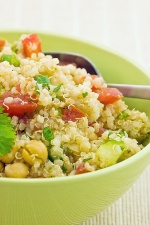 In the annals of food cures, one whole grain rises to the top of the pile. Its name is quinoa, and here are four reasons why it is considered a “superfood.”
In the annals of food cures, one whole grain rises to the top of the pile. Its name is quinoa, and here are four reasons why it is considered a “superfood.”
1. Quinoa vs. Heart Disease
Eating quinoa five or six times a week is an excellent way for older adults who might be at higher risk of heart disease because of elevated cholesterol or high blood pressure. One good study found postmenopausal women with heart disease were able to cut down the buildup of plaque in their arteries and stop their arteries from narrowing so quickly. Thus, quinoa could free up your arteries and help your heart function.
2. Quinoa vs. Migraines
Want to slash the pain of migraines by helping prevent them from striking? Add quinoa to your diet. Inside the nutritious shell of quinoa is a heaping pile of magnesium, which works inside your body to minimize the risks for a migraine. For example, it relaxes the blood vessels leading to your brain, and stops them from constricting during a migraine attack. Studies have proven that getting more magnesium in one’s diet could reduce the frequency of migraines. One such study had 80 patients take placebo or 600 mg of magnesium a day for three months. With other studies backing up the results, this study found that magnesium significantly reduced the amount of migraines—by 40%. Also, the vitamin B2 in quinoa could help prevent migraines by improving the way energy is used and created within the cells of the brain and muscle.
PLUS: Some good news for migraine sufferers.
3. Quinoa vs. High Blood Pressure
That blood vessel relaxation we just mentioned, due to magnesium’s great presence in quinoa, helps people lower the pressure inside blood vessels. So, for anyone with hypertension, or perhaps prehypertension, eating quinoa on a regular basis could lower blood pressure a little bit all by itself, and also reduce your risk of ischemic heart disease and heart arrhythmias. This, combined with the first item in this list, makes quinoa a major league whole grain for your circulatory system.
4. Quinoa vs. Gallstones
Painful stones that build up in the gallbladder can be prevented by eating such high-fiber foods as quinoa. In one telling study, gastroenterological experts studied the fiber intake of 70,000 women over 16 years. They found that those who ate fiber-rich whole grains had a 13% lower risk of developing gallstones. Those who ate the most fiber had a 17% lower risk than those who ate the least.
Quinoa helps prevent the stones because its insoluble fiber allows for healthy digestion and quicker movement of food through the intestines, but most of all because it reduces the amount of bile acids that are secreted.
Sources for Today’s Articles:
Four Common Health Problems Solved by This Superfood
Rkkila AT et al., “Cereal fiber and whole-grain intake are associated with reduced progression of coronary-artery atherosclerosis in postmenopausal women with coronary artery disease.” Am Heart J. July 2005; 150(1): 94-101.
Cephalalgia 1996; 16: 257-263.
Tsai CJ, et al., “Long-term intake of dietary fiber and decreased risk of cholecystectomy in women,” Am J Gastroenterol. July 2004; 99(7): 1,364-70.
